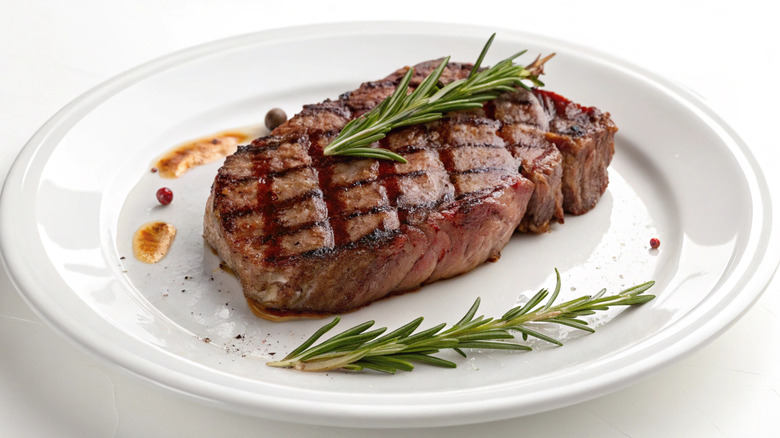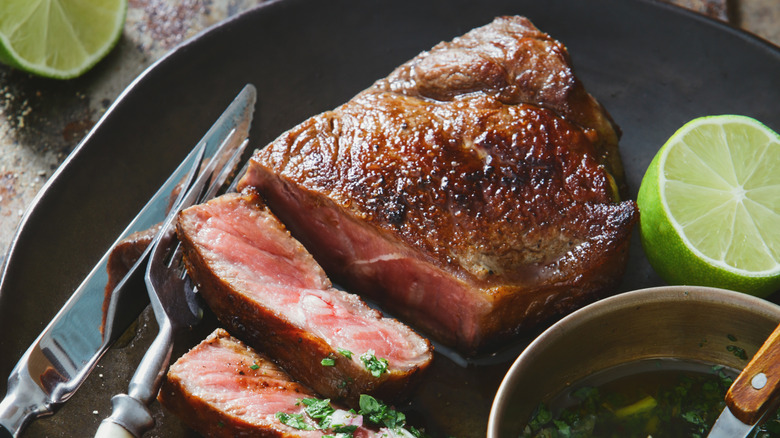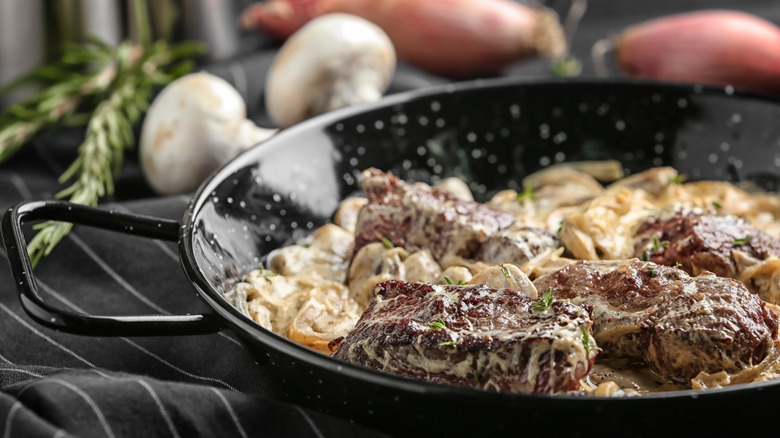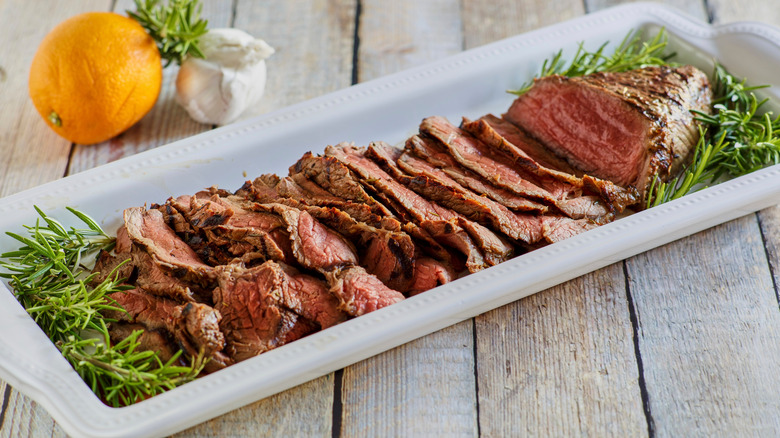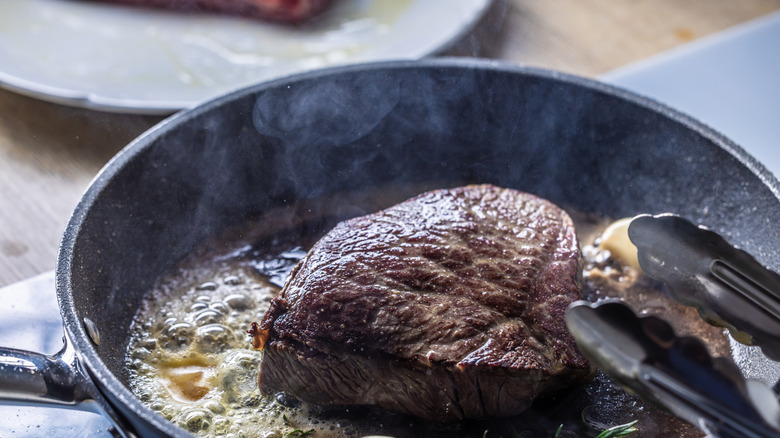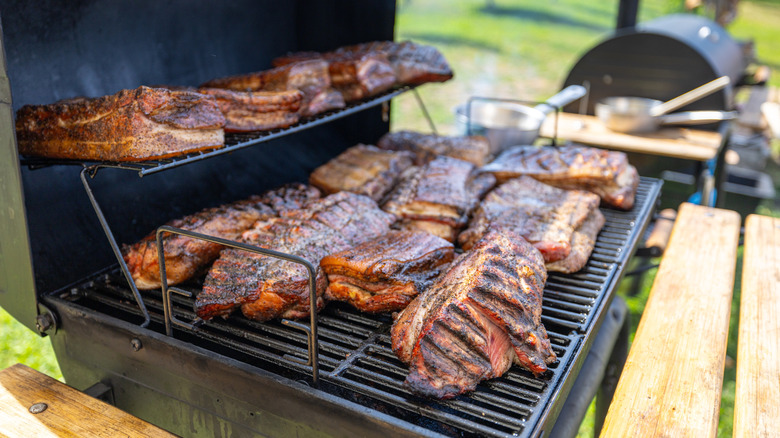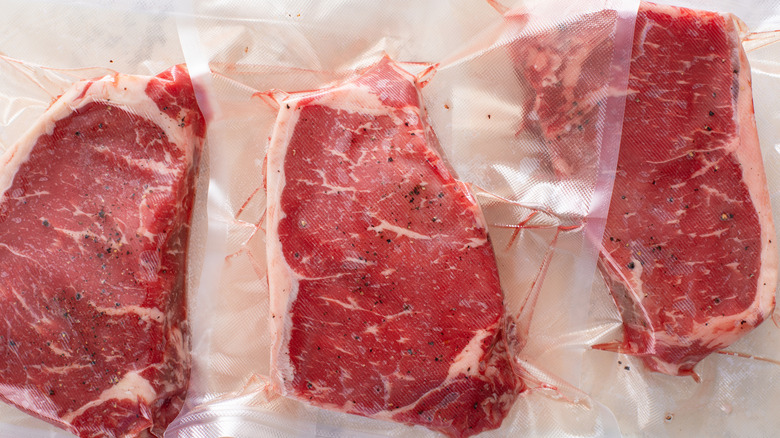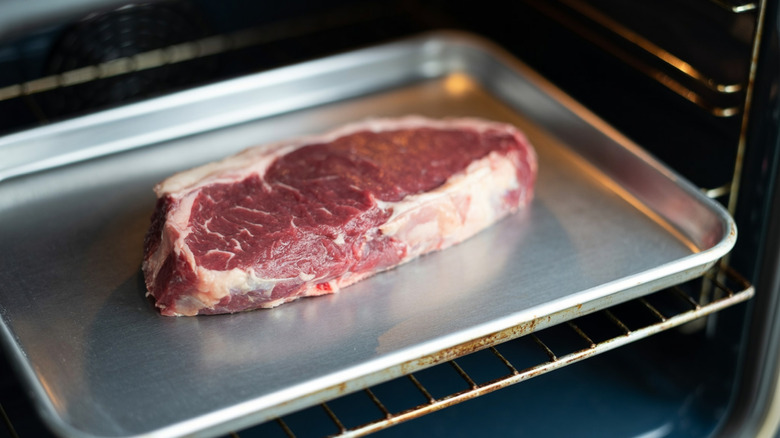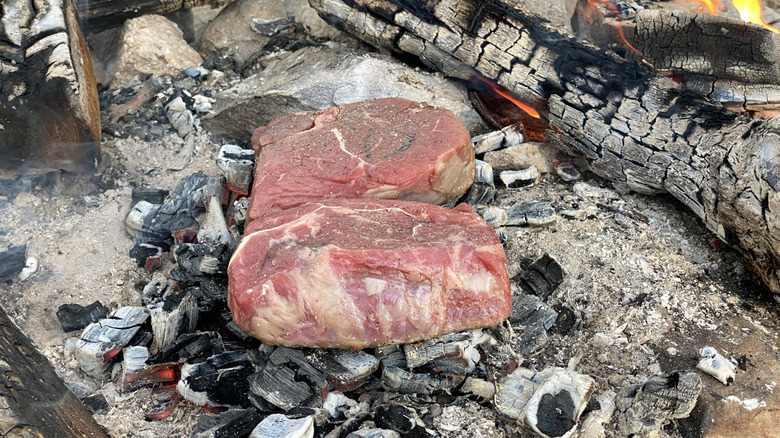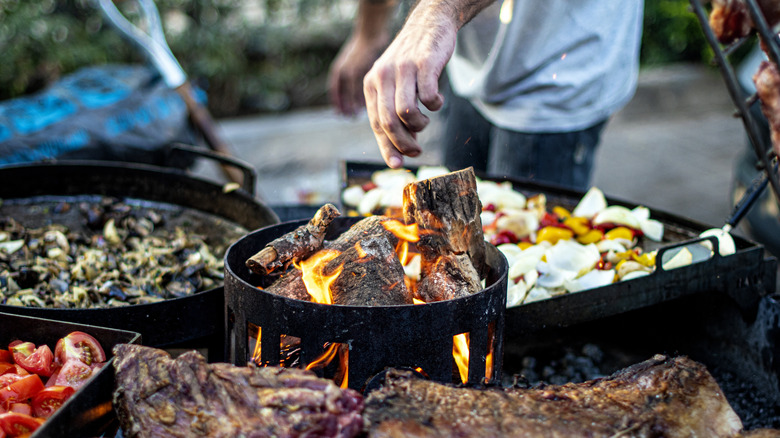Old-School Steak Cooking Methods You Need To Try
There's nothing quite like a juicy, tender steak cooked to perfection. For most people, cooking a steak means throwing it on a gas or charcoal grill and cooking it with their favorite seasonings until it reaches the preferred internal temperature. But did you know there are countless other ways to cook your steak? If you're looking to switch things up, you could consider kicking it old school and trying one of the many steak cooking methods that have been around for decades or even centuries.
Every steak cooking method will produce a slightly different taste and texture, providing you with a dish that's both familiar yet delightfully new. Some methods rely on different elements to provide unique flavor profiles, while others involve unique historical preparations you may not have thought to try in your modern kitchen. But what old-school methods exist, and how do you utilize them today? Here are 10 old-school steak cooking methods you need to try, and we think you may find that at least one becomes a regular in your steak cooking rotation.
Steak Confit
Steak confit utilizes an old cooking and preservation technique that originated in France. To "confit" something, a food is immersed in liquid and cooked for a moderate amount of time at a low setting. Today, you'll most often find confit used for tougher or stringier meats like duck, but you shouldn't shy away from using it to create a mouthwatering, flavorful steak.
To start, melt down some beef fat in a frying pan on medium-low heat and add in a generous helping of fresh garlic cloves. You'll want to cook the two together for a few minutes to impart the flavor of the garlic into the beef fat. Once done, remove the cloves and pour them into a baking dish, where you'll add your chosen piece of steak. This should be cooked slowly until it reaches your preferred internal temperature (of 125 degrees Fahrenheit or more). Finish the steak off in a pan with some basic seasonings, some of those garlic cloves from before, and a bundle of fresh thyme.
The final result will be very flavorful and juicy since it was cooked slowly, in a liquid that will partially absorb into the meat. Consider pairing your steak confit with Greek-style roasted potatoes, sauteed asparagus, and some freshly made sourdough bread.
Steak Diane
Steak Diane was popular during the 1950s and 1960s, when this dish would be cooked in fancy restaurants tableside. Why tableside? This dish comes together very quickly, so preparing it right at a customer's table could help prevent overcooking. In a contemporary kitchen, that quick cooking time can be a blessing because it allows for a steak dinner on a time crunch. Just be sure to have your mise en place ready because you won't have time to stop and prepare anything once you get started.
To prepare Steak Diane, place a very thin layer of your preferred cooking oil in a pan. Once hot, lay in very thin tenderloin steaks, shallots, fresh thyme, and mushrooms. Once this sautés for a few minutes, add a bit of mustard and some cream. When everything comes together, remove from the heat and serve immediately.
The final result will be a hearty, rich steak dish with strong earthy notes. Your steak should be tender and juicy despite the fast cooking, and you'll also have a nice amount of gravy. Serve this over mashed potatoes or rice, with a side of your favorite vegetables, sliced tomatoes, and buttery dinner rolls.
London Broil
The first documented reference to London Broil occurred in 1931, and it originated not in the English capital, but in Philadelphia, Pennsylvania. The method is uncommon today, but you can easily try it at home. The best part about London Broil? It helps make a somewhat tough piece of steak nice and tender.
To begin, take a flank steak and marinate it to your taste. It helps if you can marinate overnight, but even a few hours is sufficient. Consider something simple like Italian dressing or a combination of oil, garlic, black pepper, and thyme. Then, broil in the oven on a moderately low setting until cooked to your desired internal temperature. Once finished, quickly pan-sear only long enough to create a nice crust and cut against the grain.
London Broil leftovers make fantastic sandwiches when paired with your favorite cheese, lettuce, tomato, mayo, and mustard. For supper, consider pairing with creamy mashed potatoes, green beans, and dinner rolls.
Pan Searing
Pan searing is a simple, if intense, cooking method. Documented since at least the 1850s, pan searing may have declined in popularity because it requires constant supervision at the stovetop. However, the results justify the means, especially if you prefer a thick, crispy crust on your meat.
Start by ensuring your steak is fully thawed, and then gently pat it dry with a paper towel. Season to your preference on both sides of the meat. Salt, pepper, garlic powder, and onion powder will enhance the meat's flavor. Heat a pan on your stovetop with a light layer of oil, then lay your steak. Cook on medium-high heat until the internal temperature is just five to ten degrees less than your desired doneness. Remove from heat and rest for between five and 15 minutes, during which time the steak will continue cooking.
Pan-seared steak pairs well with many sides. If you're having it for lunch, a great choice might be a simple side salad to balance the savory flavors of the meat. For supper, you could go hearty with a baked potato, baked beans, and coleslaw.
Smoking
Smoking steak has prehistoric origins, both as a cooking method and a way to preserve meat — a trend you'll notice with many old-school steak techniques.The best part about smoking meat is that the wood imparts a unique flavor to the meat. For example, apple wood offers slightly sweet notes, while hickory has a deep, smoky flavor profile. Experimenting with wood types and complementary seasonings allows you to smoke a dozen steaks while still receiving a unique flavor profile for each one.
Start by preparing your smoker according to the instructions, using your chosen wood. For your first time, consider a combination of one-quarter hickory and three-quarters oak for a smoky but balanced profile. Season the meat according to your preference and place inside the smoker. Cook slowly, periodically checking on the meat until it's done.
Smoked meat pairs well with many things, but especially with traditional Southern barbecue sides. Potato salad, coleslaw, and traditional cornbread are good ideas. Or, you can opt for fries, baked beans, and dinner rolls if preferred.
Sous Vide Steak
The sous vide cooking method was developed by accident in the late 18th century. It was actually a science experiment that ended up perfectly cooking meat. Of course, the method wasn't popularized until the 1970s, and although it isn't often used in the home, sous vide is still sometimes used in commercial kitchens.
Sous vide involves seasoning your steak (with dry seasonings or a marinade) and then vacuum-sealing it. Once vacuum-sealed, the steak is dropped into a heated water bath, where it cooks until it reaches the desired internal temperature — usually just a few hours. Once removed, you can either eat it as-is or opt to pan-sear the steak for a nice crust and color.
Sous vide steak is another option that can be paired with a range of side dishes, depending on how you choose to season it. One option is to season your sous vide steak with rosemary, butter, olive oil, sea salt, and the tiniest pinch of fresh cracked black pepper. Pair it with roasted rosemary potatoes, sauteed broccoli, and garlic bread.
Roasting
If you want to really kick it old school with your steak, try one of the oldest cooking methods — roasting. During prehistory, roasting meant cooking meat directly over flames (similar to spit cooking), but today, this means cooking in the oven.
You're likely familiar with roasting, even if you haven't tried it with steak yet. Start by generously seasoning your steak. Compound butter is an excellent option for this, since it will help keep the steak tender during the cooking process. You can pair garlic compound butter with salt, pepper, onion powder, paprika, thyme, and rosemary. Once seasoned, place the steak into the oven in a baking dish and cook until it reaches your desired internal temperature.
Consider sautéing some mushrooms to layer on your roasted steak for added taste and texture. Pair with mashed potatoes, sweet corn, and a tossed garden salad for a balanced meal.
Caveman Steak
Caveman steaks are also called dirty steaks or fire steaks, and they're the ultimate prehistoric throwback. Caveman steaks must be made in a fire — this can be a fireplace indoors or a fire pit outdoors. You'll want to get a good fire going and prepare some coal to a scorching high heat. These coals will create a smoky flavor profile that surpasses that of even smoking or grilling. You'll cook your steak directly on these coals — don't worry about the ash. You can blow it away if you'd like, but you might blow away flavor with it.
A fun idea is to pair your caveman steak with other items that can be cooked over a campfire. For example, a baked potato can be wrapped in aluminum foil and covered with coals. If you have a campfire rack and pan, you can make most vegetables, including sauteed mushrooms and fried carrots with brown sugar.
Wood-Fired Grilling
Humans have cooked over wood for thousands of years, and at some point, Texans combined these basic principles with those of smoking, creating what we now know as modern wood-fired grilling. Essentially, this involves cooking a steak over wood using slow, indirect heat, which can be done using old-fashioned pit grilling or a modern wood pellet grill.
The process varies slightly depending on the method, but all involve heating the fire without excess smoke, which can ruin the steak's flavor with an unpleasant, sooty taste instead of a nice charred finish. Remember, the type of wood used affects flavor, too.
Be sure to pair your steak with foods suited to wood-fired grilling. Wood-fired corn on the cob, for example, has a smoky, complementary flavor. You can also wrap fresh green beans in aluminum foil with butter and garlic, throwing them on the same rack.
